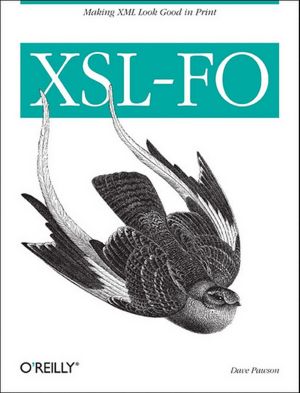Xsl-Fo: Making XML Look Good in Print epub
Par ingram jackie le mercredi, avril 27 2016, 15:01 - Lien permanent
Xsl-Fo: Making XML Look Good in Print by Dave Pawson


Xsl-Fo: Making XML Look Good in Print Dave Pawson ebook
ISBN: 9780596003555
Format: pdf
Publisher: O'Reilly Media, Incorporated
Page: 284
So, we could XSL-FO was thought by some to eventually go to the browser, but the biggest push in XSL-FO has typically been for the creation of print documents. (XPath is also used by the XML Linking specification); XSL-FO 1.0 – Extensible Stylesheet Language Formatting Objects, an XML vocabulary for specifying formatting semantics. Apache FOP (Formatting Objects Processor) is a print formatter driven by XSL formatting objects (XSL-FO). With desktop publishing (DTP) tools and help authoring tools (HATs), a moderately competent computer user can control the look and feel of the final output. I'm new to the forums and I'm asking about XSL:FO, but maybe you are so incredibly kind and could help me out a bit, maybe just with an idea. Today we do support the import and use of XML formatted elements today (CSS, XSL, and can output XSL-FO) but we would not claim that to be a standard software function. All this really means is that it makes use of a specific XML format called XSL-FO, which is built to represent printed page layout. We're quickly approaching the point (if we're not already there) at which, for some use cases, the print formatting capabilities of CSS are good enough to justify avoiding the complexity of XSL-FO. Here's a good explanation of the technique. It is much better in handling and referencing print resources for example. XSL transformations are usually a one-to-one transformation, Your first XSL will look something like this:
Can I Eat That? ebook download